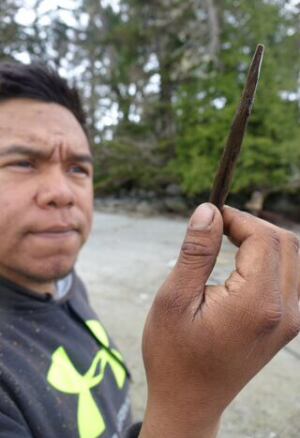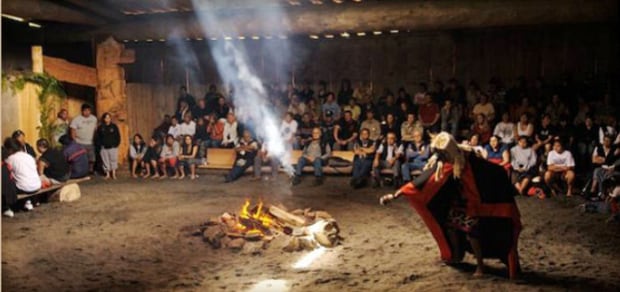An ancient archeological find on Triquet Island on B.C.'s Central Coast is adding credence to the oral histories of the Heiltsuk Nation.
"Heiltsuk oral history talks of a strip of land in that area where the excavation took place. It was a place that never froze during the ice age and it was a place where our ancestors flocked to for survival," said William Housty, a member of Heiltsuk Nation.
B.C. archaeologists have excavated a settlement in the area — in traditional Heiltsuk Nation territory — and dated it to 14,000 years ago, during the last ice age where glaciers covered much of North America.
"This find is very important because it reaffirms a lot of the history that our people have been talking about for thousands of years," Housty said.
Careful excavation
Archeologist Alisha Gauvreau, a PhD student from the University of Victoria and a scholar with the Hakai Institute, helped uncover the find.
Gauvreau and her team supported by the Hakai Institute and the Heiltsuk Nation found a number of artifacts — including carved wooden tools — at the site.
By excavating through meters of soil and peat, the team identified a paleosol — a thin horizontal layer of soil — that contained a hearth-like feature.
Very carefully, they were able to isolate a few tiny charcoal flakes from the hearth with tweezers and send it in for carbon dating.
Alisha Gauvreau, left, and Dr. Duncan McLaren, right, collect a sediment
sample below a stone artifact discovered in the site.
In November last year, tests revealed the fragments were over 14,000 years old — thousands of years older than the Roman Empire and the Egyptian pyramids.
Broad implications
Gauvreau says the site — which is one of the oldest sites of human occupation on the Northwest coast of North America — gives a new meaning to the First Nations concept of "time immemorial."
"When First Nations talk about time immemorial, it just goes to show how far back the occupation of this land goes back in deep time," she said.
The finding also has broader implications for human history — namely early North Americans travelled the coast.
One theory of how humans entered the Americas is they came from Asia over an Alaskan land bridge through an ice-free corridor east of the Rockies and made their way through what is now eastern and central Canada, she explained.
"The alternative theory, which is supported by our data as well as evidence that has come from stone tools and other carbon dating, is people were capable of travelling by boat. From our site, it is apparent that they were rather adept sea mammal hunters," she said.
Josh Vickers, of the Heiltsuk
First Nation and the archeological
team, holds up a rare 6,500
year old carved wooden bi-point.
Evidence for negotiations
Housty, who sits on the board of directors for the Heiltsuk Resource Management Department, says the scientific validation will help in future negotiations over land title and rights.
"When we do go into negotiations, our oral history is what we go to the table with," Housty said.
"So now we don't just have oral history, we have this archeological information. It's not just an arbitrary thing that anyone's making up ... We have a history supported from Western science and archeology."
Gauvreau will be presenting her team's findings at the Society for American Archeology conference in Vancouver this week.
The Heiltsuk Nation says the archaeological find which supports their oral
history will help support their claims for land title and rights.
Source: http://www.cbc.ca/news/canada/britis...tory-1.4046088
peace...
- Home
- Forum
- Chat
- Donate
- What's New?
-
Site Links

-
Avalon Library

-
External Sites

- Solari Report | Catherine Austin Fitts
- The Wall Will Fall | Vanessa Beeley
- Unsafe Space | Keri Smith
- Giza Death Star | Joseph P. Farrell
- The Last American Vagabond
- Caitlin Johnstone
- John Pilger
- Voltaire Network
- Suspicious Observers
- Peak Prosperity | Chris Martenson
- Dark Journalist
- The Black Vault
- Global Research | Michael Chossudovsky
- Corbett Report
- Infowars
- Natural News
- Ice Age Farmer
- Dr. Joseph Mercola
- Childrens Health Defense
- Geoengineering Watch | Dane Wigington
- Truthstream Media
- Unlimited Hangout | Whitney Webb
- Wikileaks index
- Vaccine Impact
- Eva Bartlett (In Gaza blog)
- Scott Ritter
- Redacted (Natalie & Clayton Morris)
- Judging Freedom (Andrew Napolitano)
- Alexander Mercouris
- The Duran
- Simplicius The Thinker







 Reply With Quote
Reply With Quote


Bookmarks